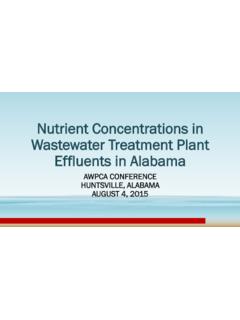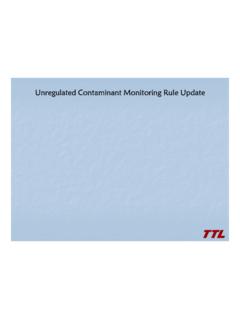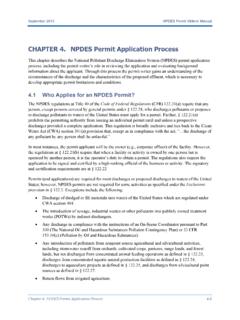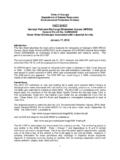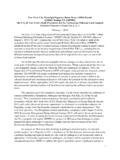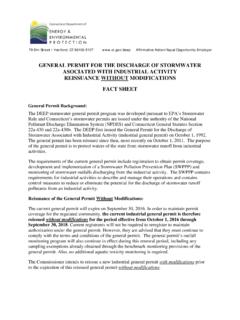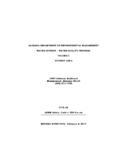Transcription of Water Quality Standards and NPDES Permits - TTL, …
1 Water Quality Standards and NPDES PermitsTTL CEH SESSIONTUSCALOOSA, ALMAY 20, 2015 Presentation Outline Background Regulatory Framework Alabama s Surface Water Quality Standards NPDES PermitsHow Did We Get Here Alabama Water Improvement Advisory Commission Federal Water Pollution Control Act Alabama Water Pollution Control Act Clean Water Act (FWPCA Amendment 1972) Alabama Environmental Management Act (1982) Construction Grants Nonpoint Source PollutionAlabama Water Improvement Commission Water Quality Studies 1948 Studies of Pollution in Alabama Streams 1949 New regulatory authority granted by legislature Additional Funding and StaffAlabama Department of Environmental Management Formed in 1982 Alabama Water Improvement Commission Alabama Department of Public Health Air Pollution Control Solid Waste Public Water SupplyWQS: Purpose Restore and maintain the chemical, physical, and biological integrity of the Nation s waters Achieve Water Quality consistent with the fishable/swimmable goal WHERE ATTAINABLEWQS: Terminology Use Classifications (ADEM Admin.)
2 Code Ch. 335-6-11) Designated Uses Who are the Users Water Quality Criteria (ADEM Admin. Code Ch. 335-6-10) Narrative Numeric Must be protective of the usesWQS: History Initial adoption by AWIC in 1967 (Cahaba & Warrior basins in 1970 1972) Amended ~ 30 times, most recently in 2014 Environmental Management Commission has authority to adopt revisions Reviewed at least once every three years (triennial review)WQS: Significance Goals and Objectives Basis for regulatory programs Framework for monitoring Yardstick for assessment Protect aquatic life and human healthWQS: Components Designated Uses (Chapter 335-6-11, ADEM Admin Code Water Use Classifications Special Designations Water Quality Criteria (Chapter 335-6-10, ADEM Admin Code General Criteria Classification-specific Criteria Nutrient Criteria for Lakes Antidegradation PolicyWater Use Classifications Outstanding Alabama Water (OAW) Public Water Supply (PWS) Shellfish Harvesting (SH) Swimming and Other Whole Body Water -contact Sports (S) Fish and Wildlife (F&W) Limited WarmwaterFishery (LWF) Agricultural and Industrial Water Supply (A&I)Special Designations Outstanding National Resource Water (ONRW) High Quality waters that constitute an outstanding National resource Little River (East and West Forks) Weeks Bay SipseyFork Treasured Alabama Lake (TAL))
3 High Quality waters within impoundments or natural lakes that constitute an exceptional resource Lake MartinClassification of Streams 77,274 miles of streams in Alabama 97 98% have the classification assigned in 1967 1972 Waterbodies can have multiple classifications Waterbodies not specifically listed are assigned the Fish and Wildlife classificationWater Quality Criteria -Narrative ADEM Admin. Code Chapter State waters shall be free from substances attributable to sewage, industrial wastes, or other Quality Criteria -Numeric Freshwater Aquatic Life Acute and Chronic Marine Aquatic Life Acute and Chronic Human HealthWater Quality Criteria -Numeric ADEM Admin Code Chapter Toxic Pollutant Criteria (109 Toxic Pollutants) ADEM Admin Code Chapter Specific Water Quality criteria vary by classification ADEM Admin Code Chapter Chlorophyll aCriteria for Lakes Ha haha, Biff.
4 Guess what? After we go to the drugstore and the post office, I m going to the vet s to get tutored. Freshwater Bacteria Criteria to Protect Recreation and Water Supplies0500100015002000250030003500 OAWSPWS (summer)PWS (winter)FW (summer)FW (winter)LWFAIC olonies/100 mlFreshwater Bacteria CriteriaGeometric MeanSingle Sample MaximumDissolved Oxygen Criteria Aquatic Life0123456 OAWSPWSFWLWF (summer)LWF (winter)AIDissolved Oxygen, mg/LDissolved Oxygen Criteria Human Health Criteria apply to all uses but are more stringent in PWS waters Criteria for most metals expressed as dissolved form Criteria for certain metals vary with stream hardnessHardness-dependent metals Cadmium Chromium (trivalent) Copper Lead Nickel Silver ZincWater Quality CriteriaHardness-dependent Metals +3 NickelCopperLeadCadmiumCriterion, ug/LChronic Aquatic Life Criteria for Selected MetalsHardness = 50 mg/L as CaCO3 Stream Hardness Effects on Aquatic Life , ug/LHardness, mg/l as CaCO3 Chronic Aquatic Life Criteria for CopperVariation with Stream HardnessMercury AcuteFreshwater ChronicMarine AcuteMarine ChronicHuman Health PWSH uman Health FWCriterion, ug/LMercury Criteria for Surface WatersDrives NPDES permit LimitsArsenic+ AcuteFreshwaterChronicMarine AcuteMarine ChronicHuman HealthPWSH uman Health FWCriterion, ug/LArsenic+3 CriteriaDrive NPDES permit LimitsNPDES permit Limits for Toxics When is a permit limit needed?
5 Answer: When the concentration in the discharge has the potential to cause the concentration in the stream to be greater than 20% of the Water Quality criterion. This calculation is called the Reasonable Potential Analysis .Example NPDES permit Limit for Copper? RPA for Copper: What we need to know to begin Receiving stream s use classification Receiving stream s 7Q10 flow Receiving stream s 1Q10 flow Wastewater flow Receiving stream s dissolved copper concentration and hardness upstream of the wastewater discharge location Partition coefficient for copper (dissolved to total recoverable) = Hilliard N. Fletcher WWTP Black Warrior River at Tuscaloosa, AL Wastewater Flow = 24 MGD ( cfs) -Qd River 7Q10 = 220 cfs -Qr River 1Q10 = 55 cfs -Qr River Hardness = 50 mg/L as CaCO3 Upstream Copper Concentration = 0 (assumed as background) -Cr Acute Freshwater Criterion for Copper = / = ppb -Cs Chronic Freshwater Criterion for Copper = / = pbb-CsExample Hilliard N.
6 Fletcher WWTP Calculate the Allowable Effluent Copper Concentration (Cd) Using the Acute Criterion and 1Q10 Flow Mass Balance Equation Cd = (CsQd+ CsQr CrQr)/Qd Cd = ( * + *55 0*55) (Acute criterion) Cd = ppb 20% of Cd = * = ppb ppb < ppb == No permit Limit Needed to Protect Acute CriterionExample Hilliard N. Fletcher WWTP Calculate the Allowable Effluent Copper Concentration to Using the Chronic Criterion and 1Q10 Flow Mass Balance Equation Cd = (CsQd+ CsQr CrQr)/Qd Cd = ( * + *220 0*220) (Chronic criterion) Cd = ppb Copper Total Recoverable 20% of Cd = * = ppb ppb > ppb == permit Limit May Be Needed to Protect Chronic Criterion (if Copper is present in the discharge) NPDES permit Limits CBOD5 Technology-based Effluent Limits or Water Quality -based Effluent Limits Ensures Protection of Instream Dissolved Oxygen Concentration Secondary Treatment = Technology-based Limits for Publicly Owned Treatment Works Secondary Treatment CBOD5 = 25 mg/L TSS = 30 mg/LDevelopment of Water Quality Based Effluent Limits Mass balance equations Water Quality models Mixing zone modelsCBOD5 vs.
7 Dissolved Oxygen0123456789024681012 Dissolved Oxygen, mg/LDistance Downstream, milesDissolved Oxygen vs. Distance DownstreamCBOD5 = 25 mg/LCBOD5 = 20 mg/LCBOD5 = 15 mg/LCBOD5 = 10 mg/LCBOD5 = 8 mg/LDO CriterionAmmonia and Organic Nitrogen NH3-N is both a toxicant and consumes oxygen as it is converted to NO3-N 1 mg/L of NH3-N uses mg/L of O2as it is converted to NO2-N and NO3-N Organic nitrogen indirectly consumes oxygen after it is converted to NH3-NCarbonaceous and Nitrogenous O2 Demand0123456789024681012 Dissolved Oxygen, mg/LDistance Downstream, milesCBOD5 + NH3-N + TONCBOD5 OnlyCBOD5+NH3-N+TONDO CriterionAmmonia Toxicity NPDES Permits may contain an NH3-N limit to: Prevent ammonia toxicity to aquatic life Maintain dissolved oxygen in the receiving stream The toxicity of NH3-N is dependent on both pH and temperature (toxicity increases with pH) EPA Recommended Ammonia Criteria -2013 Recognizes sensitivity of mussels and trout to NH3-N Include both Acute (CMC) and Chronic (CCC) Criteria Varies with both pH and temperature As pH and temperature increase, criteria decreaseEPA 2013 Chronic Toxicity Criterion for Total Ammonia Nitrogen.
8 Water ActEPA RegulationsEPA Recommended Water Quality CriteriaAlabama Water Pollution Control ActADEM Water Quality RegulationsAlabama Water Quality CriteriaAlabama s Surface Water Quality Protection Program( NPDES Permitting Program)QUESTIONS???? Contact Information Lynn SiskTTL, Inc. Montgomery, ALPhone: 334 387 1586email: Notice all the computations, theoretical scribblings, and lab equipment, Norm ..Yes, curiosity killed these cats.
